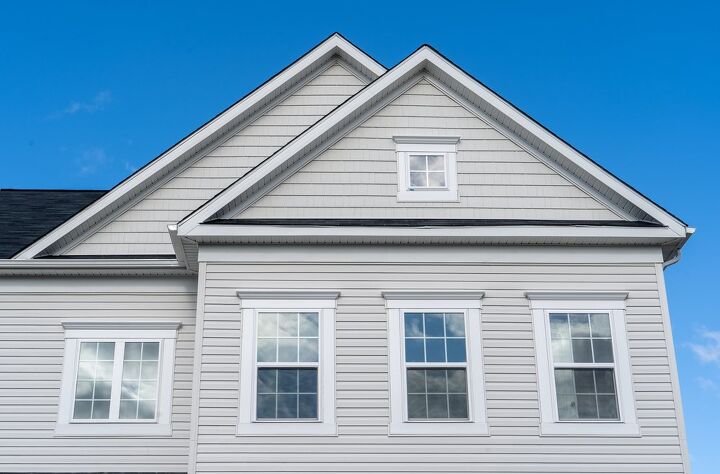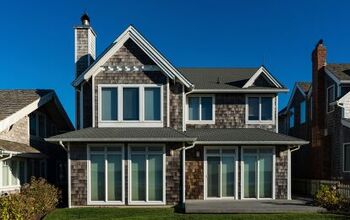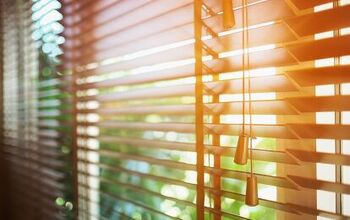Aluminum Vs. Vinyl Siding: Which One Is Better?

The exterior of your home’s cladding not only provides an aesthetic appeal but can also play a significant role in the insulation and overall protection of your home.
But when it comes time to decide on a type of siding for your home, the biggest debate tends to be aluminum vs. vinyl siding. How do you know how to pick between the two?
While aluminum siding has cheaper upfront costs, it is likely to cost you more than vinyl siding over time, due to the required maintenance. Since vinyl is more durable and thicker, it can also improve the value of your home. Vinyl also has more color, style, and plank size options. Aluminum is also more prone to damage like dents and scratches.
Do You Need Vinyl Siding Installation or Replacement?
Get free, zero-commitment quotes from pro contractors near you.

Aluminum vs. Vinyl Siding: An Overview
When it comes time to decide what type of siding is best for your home, between aluminum and vinyl, it will come down to a few different factors. You’ll not only want to consider the curb appeal but also, depending on where you live, the ability to withstand harsh weather conditions. Here are some of the top considerations when choosing between aluminum vs. vinyl siding.
Price
The pricing is always at the top of the list, as this can be a sensitive matter for homeowners. Thankfully, when it comes to choosing between aluminum and vinyl siding, you’ll find that there’s a minimal price difference between the two. If any, you’ll find that aluminum siding comes slightly cheaper than vinyl, and here’s why.
Between the two materials, vinyl siding will increase the value of your home more than its aluminum counterpart and generally has a better cost recovery. Aluminum can be prone to damages, and as such, can negatively impact the value of your home over time.
When you’re looking at pricing alone, aluminum will likely be cheaper than vinyl siding. However, when you consider the value for the price, you’ll quickly find that vinyl will be your best option. Ultimately, the decision will depend on what type of budget you’re looking for for this siding project.
Variety
While having options might not necessarily be a deal-breaker when deciding between the two materials for your exterior siding, it’s still a noteworthy feature to keep in mind. Despite the many advances of aluminum siding over the years, homeowners still find a metallic look to it. Since it’s nearly impossible to eliminate the appearance of the metal in this siding, the variety is somewhat limited in aluminum.
Vinyl siding, however, has multiple options to choose from, including standard, scalloped, vertical, dutch lap, and several others. Thanks to more recent developments in vinyl siding, today, you can even opt for a shake-style siding that gives your home the appearance of wood siding without worrying about the negative aspects of wood.
So, if you’re looking for options, vinyl siding is going to be your best bet.
Durability
One of the essential features to consider when picking your siding material is its durability, especially if you live in areas with harsher climates. It can be unfortunate for a homeowner to spend the time and money picking out your ideal siding to find out it makes your home look worn down after a few years because it’s just not holding its own.
When it comes to exterior cladding options, aluminum and vinyl are both great options in terms of durability as both materials are highly resistant to exposure and wear. Between the two, vinyl siding will reign superior as it is often double the thickness of aluminum siding.
Because of its added thickness, vinyl is known for being much stronger as a siding and less prone to scratches and dents like the aluminum alternative. So, whether you live in a climate that has hailstorms or you live nearby a golf course, you’ll want to be mindful of which material you’re choosing for your siding. Vinyl’s impact-resistant features will help to prevent any eye sores in your siding, while aluminum might not hold up as well over time.
Maintenance
Another important aspect of your exterior cladding is the required maintenance. Ideally, you want to find a material that requires the least amount of care so that you don’t have to worry about spending more time, money, or energy on touch-ups or repairs as a homeowner.
As to be expected, vinyl is going to require less maintenance over time compared to aluminum siding. Aluminum siding is prone to damage, like denting or scratching, that often involves repair or replacement if bad enough.
In addition to physical damage, aluminum siding is also more likely to fade in color over time. To keep your aluminum siding looking fresh, you’ll have to repaint it regularly. Alternatively, you do not have to worry about fading with vinyl because the color gets baked into the siding during the manufacturing process.
When you opt for vinyl siding, you can rest assured that it will stay looking as good as it did the day you installed it. The only maintenance vinyl siding requires a simple cleaning to keep it looking fresh.
Energy Efficiency
As previously mentioned, the outside cladding of your home should provide more than just aesthetic appeal, as you also want it to keep the interior of your home properly insulated. Proper protection from the outside elements helps to maintain your home’s comfortable interior temperatures without putting additional stress on your heating and cooling system and, ultimately, contributing to their wear and tear.
The clear winner in energy efficiency when looking at aluminum vs. vinyl siding will be vinyl, hands down, every time. Vinyl siding is resistant to rotting, warping, cracking and will also prevent small rodents from burrowing underneath the panels, making it all-around a more energy-efficient siding option.
Aluminum, on the other hand, does not perform well under harsh weather conditions. In extreme heat from the summer, it can absorb this heat into your home, making your interior too hot, too quickly, and forcing you to rely heavily on your air conditioning unit to maintain comfortability.
Since aluminum lacks the overall durability of vinyl, it is also more prone to damage like holes, leaks, and cracks. When aluminum siding becomes damaged, it loses its energy efficiency at more rapid rates.
Aluminum Siding
Aluminum siding was invented in the late 1930s and reached its peak in popularity over the following four decades. It became a homeowner’s favorite because of its easy to install features and lightweight design.
Pros of Aluminum Siding
The most significant benefit to having aluminum siding is affordability. Aluminum siding is known for being the cheaper option of its vinyl competitor.
Another benefit that made aluminum siding so popular in the 1940s through the 1970s was its lightweight design. Even though it is so light, it is still considered a durable material for the exterior of your home. Homeowners who are careful about maintaining their aluminum siding can easily last up to 40 years.
Cons of Aluminum Siding
It’s no secret that the lightweight body of aluminum does, unfortunately, make it prone to damages. Dents and scratches are not uncommon in this siding material and usually require professionals to come out and repair or replace them to maintain the longevity of the entire siding.
While aluminum can take paint well, it is prone to fading over time. You will likely have to paint your aluminum siding every five to 10 years to keep it looking fresh. Any oxidation that has occurred in your siding will require a labor-intensive process to be removed.
Vinyl Siding
During the aluminum siding craze, other materials began hitting the shelves. In the 1950s, vinyl siding came out as a substitute for the metal alternative. The earliest versions weren’t great as they were prone to sagging, buckling, fading, and cracking. Since then, vinyl siding has made tremendous strides and today is an industry-leading siding material.
Pros of Vinyl Siding
The list of pros well exceeds that of the cons when it comes to vinyl siding. Vinyl is an incredibly durable material that still maintains a lightweight composure. It is highly resistant to damage and an excellent insulator for your home, ensuring your interior temperatures stay more stable despite inclement weather outside.
There are also countless varieties of vinyl siding, proving that this material is fit for nearly everyone. For those looking for a wooden look, you can even find that with vinyl. Best of all, you don’t have to worry about maintaining the appearance of whichever type of finish you decide on. Vinyl siding is built to last and will stay looking fresh over a very long period.
Cons of Vinyl Siding
The installation of vinyl siding is easy enough. It can be installed on your own, but to preserve the longevity, you’ll likely want to bring in the pros. While the installation process can be easy enough, it’s not entirely fool-proof, which means that even contractors may have issues with your siding. You’ll want to make sure you check for proper certifications before hiring anyone for your install.
Depending on the climate of your area, your long-lasting vinyl siding might begin to show its wear and tear over ten to 15 years. While this is still a decent amount of time, the manufacturers will likely tell you it should last around 20 to 30 years.
Do You Need Vinyl Siding Installation or Replacement?
Get free, zero-commitment quotes from pro contractors near you.

Aluminum vs. Vinyl Siding: What’s the Verdict?
Choosing which is the better between aluminum vs. vinyl siding will more than likely result in vinyl each time.
When it comes to durability and value, there’s no denying that vinyl siding will be the optimal choice for your home. Insulate your home better, save on your energy bills, and worry less about the upkeep of your vinyl siding.
Even if you are on a budget and the price tag attached to aluminum siding might be appealing, it’s worth a second look. While the upfront costs will likely be cheaper with aluminum, you will have to consider the long-term costs over time by opting for this less durable material. Since it is prone to damage, you will likely have to have professional repairs or replacements handled over its lifetime, costing you more in the long run.
Are you interested in taking a look at alternative siding materials? Take a look at Stucco vs. Fiber Cement Siding to see if either of these options stack up to what you might be looking for for the exterior of your home.
Related Guides

We are a team of passionate homeowners, home improvement pros, and DIY enthusiasts who enjoy sharing home improvement, housekeeping, decorating, and more with other homeowners! Whether you're looking for a step-by-step guide on fixing an appliance or the cost of installing a fence, we've here to help.
More by Upgraded Home Team























![How To Reset A Whirlpool Cabrio Washer [In 5 Easy Steps!]](https://cdn-fastly.upgradedhome.com/media/2023/07/31/9076531/how-to-reset-a-whirlpool-cabrio-washer-in-5-easy-steps.jpg?size=350x220)



